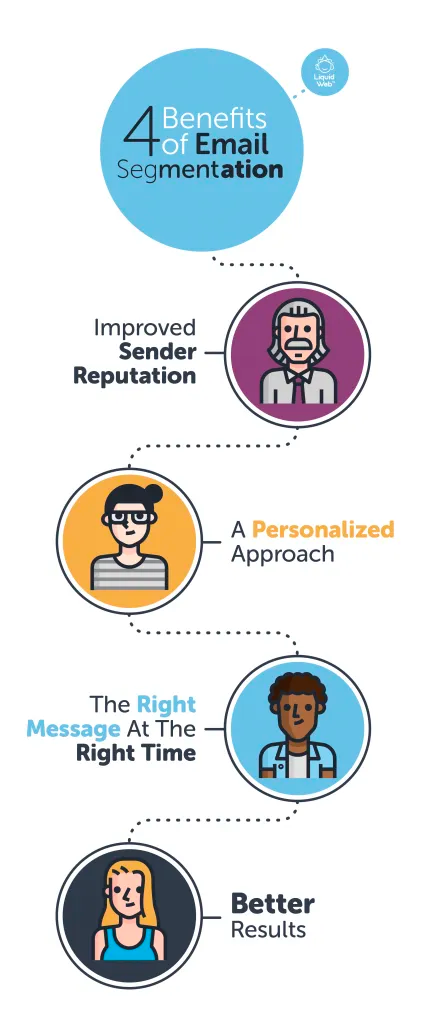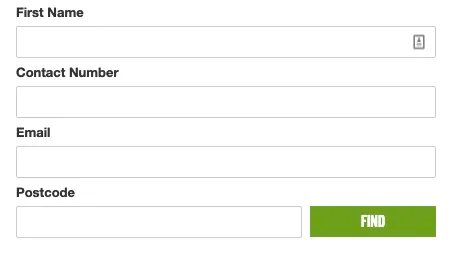An email list can be a powerful sales tool, but what’s more powerful?
A segmented email list, that’s what.
Did you know that open rates for segmented emails are 14.31% higher than for non-segmented campaigns?
Making sure your email is reaching the right audience, at the right time, and with the right content can jump-start your sales engine.
In this post, we will cover how to use email segmentation as a tactic to deliver relevant email marketing to your subscribers based on their demographics, interests, location, and purchase history.

What Is Email Segmentation?
Email segmentation is dividing up email subscribers into smaller lists (aka segments) based on set criteria.
Usually, this segmentation is used as a personalization tactic in order to deliver more relevant email marketing to subscribers.
Segments exist so that marketers can craft different offers and content for specific people based on their interests and behavior instead of just sending one email to everyone. It’s much more effective.
The 4 Benefits of Email Segmentation
There are four benefits of using market segmentation:
1. Improved Sender Reputation
Internet service providers (ISPs) calculate how recipients interact with your emails when they get them. If most aren’t engaging, then the ISP will mark that email as unimportant or may even begin to send it straight to the spam folder. Using email marketing segmentation can help deter this.
2. A Personalized Approach
With email marketing, it’s not a one size fits all, cookie-cutter approach. You need to consider how customers will respond to your messages. Not all users will respond the same.
Consider how your message will be received by different customers and how they will engage with it.
Segmenting your email list lets you speak to your customers depending on different factors (more on that later) and what they actually want. Not only do users get what they want, but you increase your chances of converting them to customers.
3. The Right Message at the Right Time
Your email list is made up of contacts that are at different stages in the sales cycle.
They need different information depending on which stage it is. Sending the wrong information at the wrong time to the wrong person is a waste of everyone’s time.
Avoid this by segmenting your list so that you never miss out on any potential sales.
4. Better Results
Here are some of the outcomes you may get using email marketing segmentation:
- Better open rates
- Higher click-through rates
- Increased revenue
- Improved deliverability
- Lower unsubscribe rates
- Additional clicks
- More engaged users
Sounds good right? Of course it does. Let’s learn about the different types of email segmentation you can apply.
Types of Market Segmentation
There are lots of different ways you can segment your email list. Let’s run through some email segmentation strategies you can start using right now.
By Demographic Data
Segmenting email lists by demographics is one of the most obvious. Things like age, gender, and income can give you a good idea about a person and their interests.
One of the simplest ways to grab this information is during the sign-up. Ask some additional questions.
An email marketing platform like Mailchimp will let you customize email sign-up questions. Just don’t ask too many questions as this can put people off from signing up.
Something as simple as this form will do the trick.

Decide what is most important for your business and include those questions in your signup process.
You can also collect more data later. Encourage subscribers to complete their profiles by offering them an incentive like a coupon or a free gift. Or simply make periodic surveying a part of your general process, such as post-purchase or every year.
By Looking at Email Engagement
Looking at email engagement is a simple but effective thing to do when it comes to segmenting your list. Open rate and click-through rate are worth your close attention.
For example, you can segment your list into active versus inactive users.
By looking at users who haven’t opened an email in months compared to users who open every email, you’ll be able to create special campaigns to try to help inactive users re-engage.
Alternatively, you’ll be able to send exclusive emails to your active users as a reward.
You may also want to consider emailing your less active subscribers less frequently. It may make them less likely to unsubscribe from your list which can happen if someone with a smaller interest in your business sees too many emails from you.
After all, open rates and unsubscribe rates are critical to the overall sendability of your list. If you have too many unsubscribes or a dismal open rate, email marketing software providers may freeze your entire account.
By Geographic Area
There are loads of different ways to use geographic data in marketing segmentation, especially for businesses with physical stores.
Again, gathering up this data doesn’t have to be complicated. Just asking for a zip/postcode on sign-up will help:

Some email software providers can even tell you where subscribers are based on their IP address when they open one of your emails. So if you don’t manually collect postal code information, you may still be able to see where your subscribers are located.
Once you know where your customers are based, there are a few things you can do with that data.
Send Time-Based Emails
Send emails at the best times for customers spread across different time zones. Some providers even allow you to do this with the click of a button.
Target Based on Weather
When featuring sales and specials, highlight cold-weather clothing to folks in colder climates, and lighter fabrics to those in warmer places.
Capitalize on Local Interests
Feature the colors of local sports teams to different regions regardless of what you sell. You could target orange and black apparel to people in Cincinnati, as those are the colors of the NFL’s Cincinnati Bengals. Or feature red items to people in Manchester, England which is the main color of Manchester United FC. Even if the item isn’t sports-related, people in these cities tend to have an affinity for these colors.
Target Geographic Tastes
Different areas may have affinities for different flavors/aromas if you are selling food products. You might promote a whiskey-flavored chocolate to people in the Southern U.S., a chili-flavored chocolate to people in the Southwest U.S. and a beer-infused chocolate to folks in the Midwest.
Past Purchase History
Understanding your user’s past purchases is a good way to improve your segmentation.
An easy method here is sending out email recommendations for similar items (or accessories) that would go well with their previous purchase.
Amazon is the master of this technique.

If a customer bought something from a particular category, there’s a good chance they will like similar products. If a customer is looking for women’s camping backpacks, they’ll likely be interested in women’s hiking shoes and apparel as well. It’s equally likely they may also require replacements or upgrades which you can also send in targeted email blasts.
Amount Spent
Do you sell a range of high and low-value items? The amount spent by each customer can be a useful segmentation strategy.
Using this data, you can find out which customers buy more high-ticket items and which are more interested in the affordable ones.
From there, you can send out emails featuring products that are in each person’s price range, and increase your chances of them converting.
Analytics allow you to see which customers only buy when they have a coupon, and which ones buy without coupons. That way, you don’t send coupons to folks who buy without them, and those who love coupons will get them.
Time Since Last Purchase
Segmenting users by time since last purchase can be a very valuable strategy.
It doesn’t make sense to send the same email to a customer who has recently made a purchase as the one who hasn’t done so for a while. Plus, it will be annoying to the customer who’s only recently purchased from you.
Instead, split them up into two groups:
- Frequent customers – these will generally like your brand and are engaged. Try upselling them products in line with their purchases or offer them promotional deals.
- One-off customers – these customers bought from you once or a few times, and haven’t purchased in a while. Try offering discounts based on past purchases or send them reminders to make a purchase.
Interests
This might be a little trickier to get working, but it’s an investment that can do wonders for your sales.
By creating user profiles, you can get detailed information about subscribers' personal interests and send them emails accordingly.
If you’ve got a massive store that sells a range of products, you can let users select which products they want to hear about in emails.

By simply asking your subscribers to pick their preferences, you can make sure your targeting is spot on with every email you send out.
Email Segmentation: A Winning Tactic
Email segmentation and targeting go hand in hand. Understanding how your market will respond can be a real boost to sales.
And since everyone can use more sales, email marketing segmentation is a tactic for businesses of all sizes to use. Your customers get what they want, and you get more sales. Everybody wins.
Managed Hosting Can Help
Armed with the tools available from managed WooCommerce hosting from Nexcess along with some creative thinking and data, you can start targeting your audience with these segmentation strategies today.
Not a Nexcess customer yet?
Check out our managed WooCommerce hosting plans to get started today.

